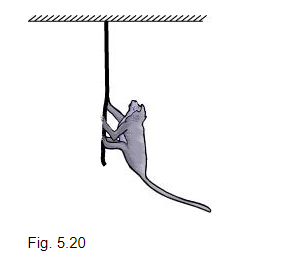Question.
A monkey of mass 40 kg climbs on a rope (Fig. 5.20) which can stand a maximum tension of 600 N. In which of the following cases will the rope break: the monkey
(a) climbs up with an acceleration of $6 \mathrm{~m} \mathrm{~s}^{-2}$
(b) climbs down with an acceleration of $4 \mathrm{~m} \mathrm{~s}^{-2}$
(c) climbs up with a uniform speed of $5 \mathrm{~m} \mathrm{~s}^{-1}$
(d) falls down the rope nearly freely under gravity?
(lgnore the mass of the rope).

A monkey of mass 40 kg climbs on a rope (Fig. 5.20) which can stand a maximum tension of 600 N. In which of the following cases will the rope break: the monkey
(a) climbs up with an acceleration of $6 \mathrm{~m} \mathrm{~s}^{-2}$
(b) climbs down with an acceleration of $4 \mathrm{~m} \mathrm{~s}^{-2}$
(c) climbs up with a uniform speed of $5 \mathrm{~m} \mathrm{~s}^{-1}$
(d) falls down the rope nearly freely under gravity?
(lgnore the mass of the rope).

solution:
Case (a)
Mass of the monkey, m = 40 kg
Acceleration due to gravity, g = 10 m/s
Maximum tension that the rope can bear, $T_{\max }=600 \mathrm{~N}$
Acceleration of the monkey, $a=6 \mathrm{~m} / \mathrm{s}^{2}$ upward
Using Newton's second law of motion, we can write the equation of motion as:
$T-m g=m a$
$\therefore T=m(g+a)$
$=40(10+6)$
$=640 \mathrm{~N}$
Since $T>T_{\max }$, the rope will break in this case.
Case (b)
Acceleration of the monkey, $a=4 \mathrm{~m} / \mathrm{s}^{2}$ downward
Using Newton’s second law of motion, we can write the equation of motion as:
$m g-T=m a$
$\therefore T=m(g-a)$
$=40(10-4)$
$=240 \mathrm{~N}$
Since $T
Case (c)
The monkey is climbing with a uniform speed of 5 m/s. Therefore, its acceleration is zero, i.e., a = 0.
Using Newton’s second law of motion, we can write the equation of motion as:
T – mg = ma
T – mg = 0
$\therefore T=m g$
$=40 \times 10$
= 400 N
Since $T
Case (d)
When the monkey falls freely under gravity, its will acceleration become equal to the acceleration due to gravity, i.e., a = g
Using Newton’s second law of motion, we can write the equation of motion as:
mg – T = mg
$\therefore T=m(g-g)=0$
Since $T
Case (a)
Mass of the monkey, m = 40 kg
Acceleration due to gravity, g = 10 m/s
Maximum tension that the rope can bear, $T_{\max }=600 \mathrm{~N}$
Acceleration of the monkey, $a=6 \mathrm{~m} / \mathrm{s}^{2}$ upward
Using Newton's second law of motion, we can write the equation of motion as:
$T-m g=m a$
$\therefore T=m(g+a)$
$=40(10+6)$
$=640 \mathrm{~N}$
Since $T>T_{\max }$, the rope will break in this case.
Case (b)
Acceleration of the monkey, $a=4 \mathrm{~m} / \mathrm{s}^{2}$ downward
Using Newton’s second law of motion, we can write the equation of motion as:
$m g-T=m a$
$\therefore T=m(g-a)$
$=40(10-4)$
$=240 \mathrm{~N}$
Since $T
Case (c)
The monkey is climbing with a uniform speed of 5 m/s. Therefore, its acceleration is zero, i.e., a = 0.
Using Newton’s second law of motion, we can write the equation of motion as:
T – mg = ma
T – mg = 0
$\therefore T=m g$
$=40 \times 10$
= 400 N
Since $T
Case (d)
When the monkey falls freely under gravity, its will acceleration become equal to the acceleration due to gravity, i.e., a = g
Using Newton’s second law of motion, we can write the equation of motion as:
mg – T = mg
$\therefore T=m(g-g)=0$
Since $T
Click here to get exam-ready with eSaral
For making your preparation journey smoother of JEE, NEET and Class 8 to 10, grab our app now.
